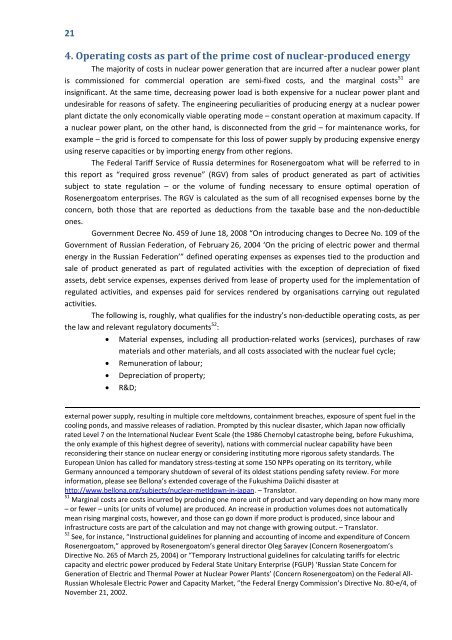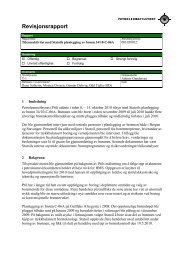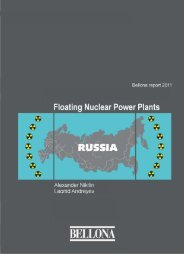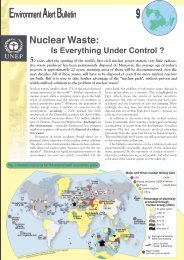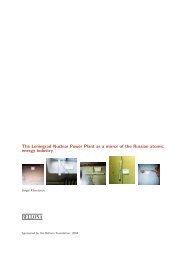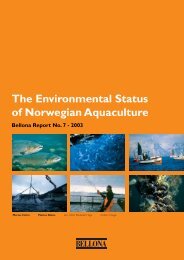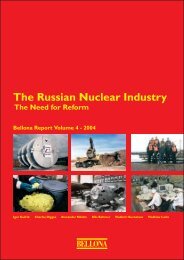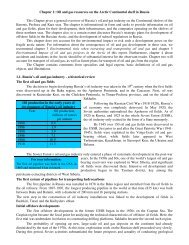20requirements: If a wrong decision has been made, bankruptcy follows. In situations where statefinancing is involved, such restrictions are always more flexible, but <strong>the</strong> responsibility for <strong>the</strong>consequences that this or that economic decision will have is deferred so far ahead into <strong>the</strong> future that,for all intents and purposes, it simply does not exist in any practical sense. In essence, <strong>the</strong> veryorganisation <strong>of</strong> making investment decisions in projects undertaken in <strong>the</strong> nuclear power industrymakes it so that <strong>the</strong> responsibility for errors <strong>of</strong> judgment and <strong>the</strong> ensuing repercussions lies with no onein particular. For instance, <strong>the</strong> obvious economic fiasco <strong>of</strong> <strong>the</strong> idea <strong>of</strong> floating nuclear power plants, 49<strong>the</strong> exponential growth in costs <strong>of</strong> new reactor construction, and construction delays at new sites do notseem to complicate <strong>the</strong> lives <strong>of</strong> those who were responsible for <strong>the</strong> initiation and implementation <strong>of</strong><strong>the</strong>se projects in <strong>the</strong> first place.Where nuclear energy differs prominently from all o<strong>the</strong>r sources <strong>of</strong> energy is <strong>the</strong> absence <strong>of</strong><strong>the</strong> inverse relationship between technological progress and production costs. As technologiesdevelop and are better known and used more efficiently, production costs decrease, and thisfeedback effect holds for all o<strong>the</strong>r energy generation sectors – but not <strong>the</strong> nuclear energy industry,where <strong>the</strong> costs <strong>of</strong> producing power from nuclear reactors keep growing instead.<strong>The</strong>re is a considerable number <strong>of</strong> <strong>the</strong>ories explaining this phenomenon, <strong>of</strong> which <strong>the</strong> first andforemost is <strong>the</strong> idea <strong>of</strong> perception <strong>of</strong> <strong>the</strong> industry as a dangerous and harmful one – something thatresults in ever stricter requirements and standards imposed with regard to its safety. <strong>The</strong> availability <strong>of</strong>technological improvements to enhance safety <strong>of</strong> nuclear power plants makes it impossible to avoidtoughening safety regulations correspondingly, and it is very difficult to draw <strong>the</strong> line between <strong>the</strong>necessary safety enhancements and <strong>the</strong> price which must be paid to achieve <strong>the</strong>m. Indeed, if <strong>the</strong>re aremeasures to limit <strong>the</strong> risks <strong>of</strong> accidents that threaten environmental contamination and harm topopulation health and yet <strong>the</strong>y are not installed for reasons <strong>of</strong> economic considerations, <strong>the</strong>n in caseswhen such risks do erupt into real accidents, <strong>the</strong> industry is bound to be hard‐pressed to explain to <strong>the</strong>public why <strong>the</strong>se measures were not applied.For instance, experts pointed out in numerous studies that have been done in <strong>the</strong> wake <strong>of</strong> <strong>the</strong>1986 catastrophe at Ukraine’s Chernobyl <strong>Nuclear</strong> <strong>Power</strong> Plant that Soviet designers had been puttingtoo strong an emphasis on cutting costs – at <strong>the</strong> expense <strong>of</strong> safety at <strong>the</strong> plant and protection againstaccidents. It is obvious, in hindsight, that any measures that could have prevented that terrible disastershould have been used, no matter what <strong>the</strong> cost. But for Soviet nuclear specialists at <strong>the</strong> time, accidentrisks appeared too infinitesimal and safety standards too high. In any case, because nuclear projects arecharacterised with extremely long time horizons, investors should be prepared to face tidal shifts in <strong>the</strong>prevailing attitudes to <strong>the</strong> industry – which, at <strong>the</strong> very least, may lead to changes in standards andregulations and corresponding cost increases. 5049 Please see Appendix to this report, which details <strong>the</strong> economic deficiencies <strong>of</strong> <strong>the</strong> floating nuclear power plant(FNPP) project, a concept <strong>of</strong> non‐self‐propelled vessels with reactors on board devised to supply power in remoteand poorly accessible regions. A first in a projected series <strong>of</strong> at least seven such plants is being completed atBaltiisky Zavod in St. Petersburg to be subsequently towed to <strong>the</strong> Kamchatka Peninsula in <strong>the</strong> <strong>Russian</strong> Far East.Rosatom admits that <strong>the</strong> project will not be economically viable unless at least several FNPPs are built in acommercial series and hopes to start serial production <strong>of</strong> <strong>the</strong>se transportable nuclear power plants for export too<strong>the</strong>r countries, primarily in Sou<strong>the</strong>ast Asia. An extensive report has been written by Alexander Nikitin and LeonidAndreev, with participation by experts at <strong>Bellona</strong> and o<strong>the</strong>r organisations, on <strong>the</strong> FNPP endeavour and <strong>the</strong> manyrisks – those <strong>of</strong> safety and security primarily, and expediency overall – that it entails. To read <strong>the</strong> report, entitled“Floating <strong>Nuclear</strong> <strong>Power</strong> Plants,” <strong>Bellona</strong> Report 2011, please visit <strong>Bellona</strong>’s website at www.bellona.org. –Translator.50 A more recent wave <strong>of</strong> revisions <strong>of</strong> safety standards swept across <strong>the</strong> global nuclear industry following <strong>the</strong> onset<strong>of</strong> <strong>the</strong> still ongoing, as <strong>of</strong> mid‐April 2011, nuclear disaster at Japan’s Fukushima Daiichi <strong>Nuclear</strong> <strong>Power</strong> Plant, wherean 8.9‐magnitude earthquake <strong>of</strong> March 11 and a devastating tsunami that hit in its wake destroyed <strong>the</strong> station’s
214. Operating costs as part <strong>of</strong> <strong>the</strong> prime cost <strong>of</strong> nuclear‐produced energy<strong>The</strong> majority <strong>of</strong> costs in nuclear power generation that are incurred after a nuclear power plantis commissioned for commercial operation are semi‐fixed costs, and <strong>the</strong> marginal costs 51 areinsignificant. At <strong>the</strong> same time, decreasing power load is both expensive for a nuclear power plant andundesirable for reasons <strong>of</strong> safety. <strong>The</strong> engineering peculiarities <strong>of</strong> producing energy at a nuclear powerplant dictate <strong>the</strong> only economically viable operating mode – constant operation at maximum capacity. Ifa nuclear power plant, on <strong>the</strong> o<strong>the</strong>r hand, is disconnected from <strong>the</strong> grid – for maintenance works, forexample – <strong>the</strong> grid is forced to compensate for this loss <strong>of</strong> power supply by producing expensive energyusing reserve capacities or by importing energy from o<strong>the</strong>r regions.<strong>The</strong> Federal Tariff Service <strong>of</strong> Russia determines for Rosenergoatom what will be referred to inthis report as “required gross revenue” (RGV) from sales <strong>of</strong> product generated as part <strong>of</strong> activitiessubject to state regulation – or <strong>the</strong> volume <strong>of</strong> funding necessary to ensure optimal operation <strong>of</strong>Rosenergoatom enterprises. <strong>The</strong> RGV is calculated as <strong>the</strong> sum <strong>of</strong> all recognised expenses borne by <strong>the</strong>concern, both those that are reported as deductions from <strong>the</strong> taxable base and <strong>the</strong> non‐deductibleones.Government Decree No. 459 <strong>of</strong> June 18, 2008 “On introducing changes to Decree No. 109 <strong>of</strong> <strong>the</strong>Government <strong>of</strong> <strong>Russian</strong> Federation, <strong>of</strong> February 26, 2004 ‘On <strong>the</strong> pricing <strong>of</strong> electric power and <strong>the</strong>rmalenergy in <strong>the</strong> <strong>Russian</strong> Federation’” defined operating expenses as expenses tied to <strong>the</strong> production andsale <strong>of</strong> product generated as part <strong>of</strong> regulated activities with <strong>the</strong> exception <strong>of</strong> depreciation <strong>of</strong> fixedassets, debt service expenses, expenses derived from lease <strong>of</strong> property used for <strong>the</strong> implementation <strong>of</strong>regulated activities, and expenses paid for services rendered by organisations carrying out regulatedactivities.<strong>The</strong> following is, roughly, what qualifies for <strong>the</strong> industry’s non‐deductible operating costs, as per<strong>the</strong> law and relevant regulatory documents 52 :Material expenses, including all production‐related works (services), purchases <strong>of</strong> rawmaterials and o<strong>the</strong>r materials, and all costs associated with <strong>the</strong> nuclear fuel cycle;Remuneration <strong>of</strong> labour;Depreciation <strong>of</strong> property;R&D;external power supply, resulting in multiple core meltdowns, containment breaches, exposure <strong>of</strong> spent fuel in <strong>the</strong>cooling ponds, and massive releases <strong>of</strong> radiation. Prompted by this nuclear disaster, which Japan now <strong>of</strong>ficiallyrated Level 7 on <strong>the</strong> International <strong>Nuclear</strong> Event Scale (<strong>the</strong> 1986 Chernobyl catastrophe being, before Fukushima,<strong>the</strong> only example <strong>of</strong> this highest degree <strong>of</strong> severity), nations with commercial nuclear capability have beenreconsidering <strong>the</strong>ir stance on nuclear energy or considering instituting more rigorous safety standards. <strong>The</strong>European Union has called for mandatory stress‐testing at some 150 NPPs operating on its territory, whileGermany announced a temporary shutdown <strong>of</strong> several <strong>of</strong> its oldest stations pending safety review. For moreinformation, please see <strong>Bellona</strong>’s extended coverage <strong>of</strong> <strong>the</strong> Fukushima Daiichi disaster athttp://www.bellona.org/subjects/nuclear‐metldown‐in‐japan. – Translator.51 Marginal costs are costs incurred by producing one more unit <strong>of</strong> product and vary depending on how many more– or fewer – units (or units <strong>of</strong> volume) are produced. An increase in production volumes does not automaticallymean rising marginal costs, however, and those can go down if more product is produced, since labour andinfrastructure costs are part <strong>of</strong> <strong>the</strong> calculation and may not change with growing output. – Translator.52 See, for instance, “Instructional guidelines for planning and accounting <strong>of</strong> income and expenditure <strong>of</strong> ConcernRosenergoatom,” approved by Rosenergoatom’s general director Oleg Sarayev (Concern Rosenergoatom’sDirective No. 265 <strong>of</strong> March 25, 2004) or “Temporary Instructional guidelines for calculating tariffs for electriccapacity and electric power produced by Federal State Unitary Enterprise (FGUP) ‘<strong>Russian</strong> State Concern forGeneration <strong>of</strong> Electric and <strong>The</strong>rmal <strong>Power</strong> at <strong>Nuclear</strong> <strong>Power</strong> Plants’ (Concern Rosenergoatom) on <strong>the</strong> Federal All‐<strong>Russian</strong> Wholesale Electric <strong>Power</strong> and Capacity Market, ”<strong>the</strong> Federal Energy Commission’s Directive No. 80‐e/4, <strong>of</strong>November 21, 2002.
- Page 2 and 3: …Nuclear power generation is the
- Page 4 and 5: Translator’s notes:Rules of etiqu
- Page 6 and 7: 6ForewordThe economy of the Russian
- Page 8 and 9: 8of everything that the nuclear pow
- Page 10 and 11: 10Real costs of nuclear power plant
- Page 12 and 13: 12Energy Potential Development,”
- Page 14 and 15: 14noticeably higher than the regula
- Page 16 and 17: 16came to 2.2 billion kilowatt‐ho
- Page 18 and 19: 183. Problems of nuclear power indu
- Page 22 and 23: 22Property and liability insurance;
- Page 24 and 25: 24Depreciation 10,911,630 9,312,654
- Page 26 and 27: 26low prices, because a decrease in
- Page 28 and 29: 28Fig. 2. Spot prices for U 3 O 8 c
- Page 30 and 31: 30uranium needs and the demand it h
- Page 32 and 33: 32remains unclear what can be done
- Page 34 and 35: 34For instance, British energy comp
- Page 36 and 37: 36But Rosenergoatom’s real expens
- Page 38 and 39: 38contribution benefit plans, inclu
- Page 40 and 41: 40Table 11. Costs of decommissionin
- Page 42 and 43: 42And thirdly, traditional approach
- Page 44 and 45: 44The discount rate will be the var
- Page 46 and 47: 46Cost ofcapitalTable 15. Price of
- Page 48 and 49: 48operation as a baseload generatin
- Page 50 and 51: 505 percent0 percent367.0 614.3 3.7
- Page 52 and 53: 52The idea to develop the sector of
- Page 54 and 55: 54Even if we assume that the direct
- Page 56 and 57: 56Furthermore, the total cost of bu
- Page 58 and 59: 5811. Instructional guidelines for
- Page 60: 60Greenpeace, 01.04.2004,http://www


